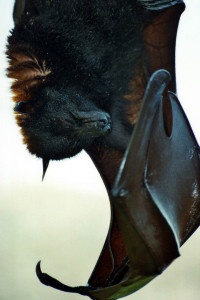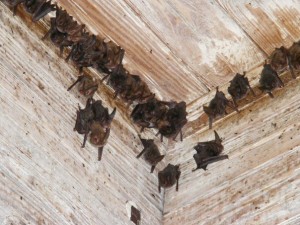We have much more to do and your continued support is needed now more than ever.
10 Reasons You Should Love Bats
Guest post by Ela-Sita Carpenter
Lets face it, bats get a pretty bad rep. Many times in the media they are portrayed as scary, blood sucking, rabid creatures. The vast majority of bats will never get rabies. And quite a few species can be pretty darn cute! As someone who has spent time studying bats in the wild, I jumped at the opportunity to share what I’ve learned with others—it’s something I believe all biologists should do. Here are my reasons for liking bats (and why you should like them too!).
1: They’re our relatives.
Many people refer to bats as “flying mice,” but in truth bats are more closely related to humans than they are to rodents. And aren’t we supposed to be nice to our relatives?

2: They’re an INCREDIBLY diverse group of mammals.
Bats are the second largest group of mammals in the world and consist of over 1,300 species. Among these species are bats that eat fruit, insects, nectar, meat and blood (only three species eat this way). Bats’ wingspan can range from 6 inches long (bumblebee bat) to 6 feet long (several bat species known as flying foxes)! There are bats in every continent but Antarctica that live in caves, hollow trees, under loose tree bark, on tree branches and even man-made structures like bridges, wells, mines and buildings! In some species bats live alone, while others live in colonies of a few dozen, hundreds, thousands or even millions! And the variety of physical appearances is astounding, with species having an assortment of facial features, fur patterns, color and tail and ear lengths. Others have been given nicknames based on their appearances, such as the hammerhead bat, painted bat, the recently-discovered badger bat, and the Yoda bat!
3: They’re the only mammals that can fly.
Bats can actively control their flight, whereas “flying” squirrels can only glide (sorry guys!).
4: They can see with their ears.
Bats aren’t blind and can use their eyes. However, many species use echolocation to find their prey and “see” their surroundings. They make calls that will travel through the air until it hits an object. This call then bounces off the object and echos back to the bat, letting them know where the object is (so its unlikely that they’ll fly in your hair). Bats can make up to 160 calls per SECOND as they close in on their prey. This would seem like a noisy way to get food, but most bat calls are at ultrasound frequencies that are too high for us (and their prey) to hear.
5: They are really good pest exterminators.
Many bats eat LOTS of bugs! By doing this, bats reduce the amount of pesticides farmers need to use (which also means less pesticides polluting the environment) and they reduce the amount of produce damaged by pests (which means more food for us!). Recently scientists estimated that bats in the United States have save us somewhere between $3.7 and 54 billion in pest control services every year. Bats have been documented eating bugs that attack pecans, almonds, rice, cotton, corn, coffee, sugarcane, tomatoes, cucumbers and beans.
6: They help produce some of our favorite foods.

7: They are gardeners of the rainforest.
Fruit bats do this by a process called seed dispersal. These bats eat fruit and their seeds, fly away and disperse the seeds in a different location via their feces. By moving seeds away from the parent plant, bats allow these seeds to grow in an area where they’ll be more likely to grow without competition from the parent plant. One estimate found that one square meter of the rainforest floor on average may contain 12-80 bat-dispersed seeds each year. These include plants like figs, palms, Jamaican pepper (also know as allspice) and cacao, from which we get chocolate!
8: Their guano is good for our gardens.
Guano (aka bat poop) is contains nitrogen, potassium, and phosphate which helps plant, root and flower health and growth. And many people buy and use bat guano in their gardens! Don’t believe me?
9: They’re contributing to human health.
Scientists have extracted a compound from vampire bat saliva and turned it into medicine (aptly named Draculin). Studies have fond this anticoagulant drug to be very useful for stroke patients. Scientists are also studying bats’ resistance to DNA damage and malaria parasites in hopes of learning more about human DNA damage and how to better deal with malaria.
10: They’re fun to study!

So bats are nothing to be scared of. In fact, bats are facing something very scary themselves: a disease called white-nose syndrome, which has killed over 5 million bats since first appearing in a New York cave in 2006. Bats are also facing mortality from wind turbines, habitat loss, vandalism of their roosts, and as a source of bush meat in other countries.
How Can We Help Bats?
We can help bats out by creating and protecting habitat for them: If you have old or dead trees on your property, leave them standing (if its safe to do so). Bat houses are another great way to provide bats with a safe place to live. If you know where bats are roosting, do not disturb them, especially in early summer (when pups are being born and cant fly) or during the winter (when they are hibernating). You can also become a member of a bat conservation group who use their resources to help bats or get involved with National Wildlife Federation. The scariest thing of all would be if bats disappeared!
About the Author
 This is a guest post by Ela-Sita Carpenter, M.S., who is a volunteer naturalist with the Natural History Society of Maryland. Her thesis research focused on abandoned building roosts of Rafinesque’s big-eared bats in southern Virginia. She’s also studied bats in Nevada, shorebirds on Virginia’s barrier islands, and conducted urban bird surveys in Baltimore.
This is a guest post by Ela-Sita Carpenter, M.S., who is a volunteer naturalist with the Natural History Society of Maryland. Her thesis research focused on abandoned building roosts of Rafinesque’s big-eared bats in southern Virginia. She’s also studied bats in Nevada, shorebirds on Virginia’s barrier islands, and conducted urban bird surveys in Baltimore.





















